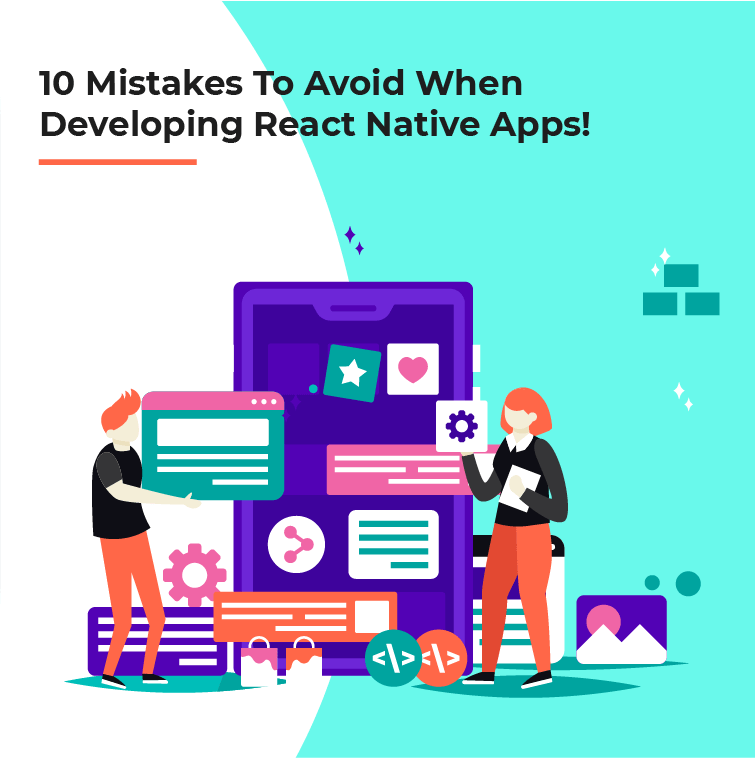React Native is a mobile app framework created by Facebook. It is open-source and is based on JavaScript. React Native facilitates the use of React’s framework with the capabilities of native platforms. React Native has the facility of building cross-platform applications for iOS, Android Windows, etc. It uses the same codebase with a better user experience. This means that the same code can be shared by different platforms. React Native Developer can save time and resources. Thus they feel and look truly native.
React Native framework is a highly scalable application. It is used by reputed companies such as Skype, Facebook, and Uber. There is great community support behind it; despite its popularity, React Native Development Company faces some significant challenges and is thus are likely to make some mistakes during its Development. Therefore, the React Active Developer must make the best utilization of the JavaScript syntax so that any negative impact does not come into the picture. They have to be well-versed and avoid the most common mistakes.
Top 10 Mistakes to be avoided…
You must consider the following aspects when you are developing React Native applications; let’s read further:
1: Incorrect Estimation
React Native has some reusable components and code reusability. While developing React Native App, developers should know that the layout of an app page and the page structure varies significantly on different platforms. Moreover, while creating a web application, the developers need to check all the endpoints offered by the backend.
The app logic can be adequately handled only if the endpoints are coded correctly. Therefore while estimating your requirement, you must prepare for two different layouts and keep the database structure in mind.
2: Reading the Codes of External Modules
The mistake will arise if you don’t read these. Developing external modules is common and saves considerable time when applied. It becomes easier as they are tagged with the documentation.
But unfortunately, sometimes, the modules do not work to the expectation or may even break. Therefore it is essential that you pay utmost attention to the code and read them to avoid any mistake. You can then identify the problems associated with the module and get the proper guidance for tackling and solving the issues.
3: Coding Practices
If the coding practice is terrible, you won’t extend the application by leveraging the practices. Moreover, you will have to make modifications time and again if the needs exceed. Code can’t be opened. Hence you need to write a large piece of code. For a better solution, if you have started coding, avoid coming up with a plan.
First, form a plan, after which you should go in for coding. For better Code readability, you must adopt befitting coding practices. Adoption of property restructuring is an effective option. Name the variables such as methods, separate life cycle, and elements in the Component.
4: Incorrect Planning
While developing react Native Apps, more focus needs to be put on planning the application’s layout. Handling of data should be focused less. To make the task still easier, you can make use of Redux. It is a tool to manage and store the app data effectively, particularly in large-scale applications.
Even for minor modifications, you will be required to write the same lengthy code. So, you should use Redux for larger applications and avoid it for smaller projects. Redux may mess up with debugging, logic tests, and application data flow if not appropriately planned. It would help if you adopted as below:
- By forming a store hierarchy, arrange your files
- Include the first reducer function
- Inclusion and integration of more reducers
- Configuration of the store
- Add middleware
5: Console Log Statement
This statement helps in debugging the app execution. But if the console.log iOS is left in the app, it becomes critical to affecting the JavaScript thread. Moreover, the application will be slower as it involves calls from the Redux logger, the document libraries.
6: Unit Test Unwritten
Another mistake that may arise while developing React Native Apps is not performing the Unit Test. This probably is because of the ingrained habit of not writing the Unit Test. Moving ahead without a written test is risky. It becomes a strenuous task to address the bugs and other issues at the last moment.
Products with glitches create a negative impression concerning the product and brand. To avoid such eventuality, you need to test the product’s functionality and be OK before release.
7: Use of Stateless Component
The stateless Component can test quickly, but they are not effective in the present scenario. Pure Component accelerates the Development of React Native .and facilitates Shallow comparison automatically. Its complex User Interface brings down render operations because it comes with a Lifecycle method.
8: Direct Mutation
View and Datastore are closely associated. Datastore carries the entire data in components, whereas view is rendered based on the state for which it consumes a new form from the store and displays the same on the screen. In the case of direct state mutation, the conditions mentioned above are corrupted, and the lifecycle is disturbed. Moreover, you will be limited by a heavy application and unmanageable code.
9: Unoptimized Images
If the images are not optimized, it consumes a vast space and more significant memory. Therefore never make the mistake of leaving the image unoptimized. By optimizing the image, you can:
- Make the image smaller before uploading the same into React.
- The Webpage format accelerates the load time and reduces binary sizes bundle
- Local caching of images
- PNG before JPG
10: Ignoring Project Structure
Mobile Application Development includes React Native developers who may commit the mistake of organizing their project structure. They may also err from not investing in the framework, thus making it difficult to maintain the project. The best option for you is to structure the projects.
Conclusion!
Developers must avoid these common mistakes while developing React Native Apps to ensure these applications’ smooth and excellent functioning.

